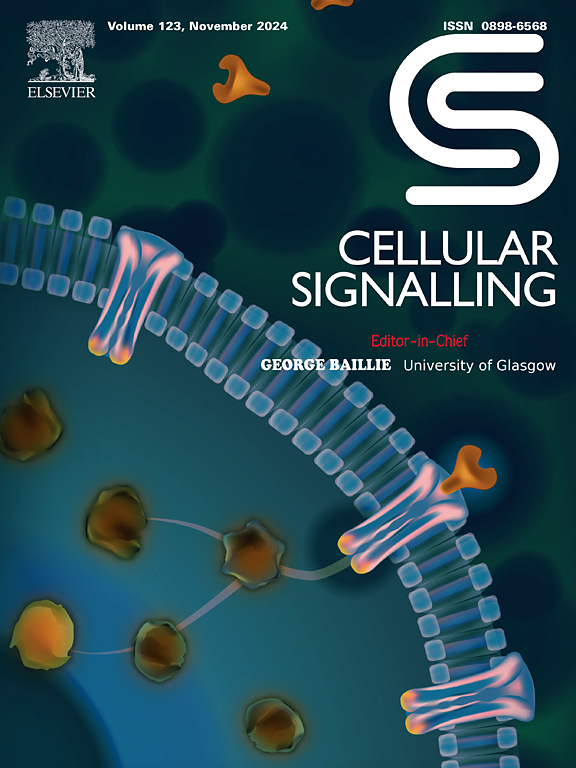miR-27a-3p下调诱导内皮损伤和衰老及其在冠心病发生中的意义
IF 4.4
2区 生物学
Q2 CELL BIOLOGY
引用次数: 0
摘要
miR-27a-3p 是一种多功能 miRNA,在血管生成过程中发挥着关键作用。然而,它对冠心病(CHD)的具体影响,特别是对下游分子的调控以及由此导致的内皮细胞损伤的影响,尚未完全阐明。本研究旨在利用 RT-qPCR、RNA 测序和生物信息学等技术,在 CHD 患者和模型内皮细胞中探讨 miR-27a-3p 与 CHD 的关系及其潜在的机械分子通路。结果发现,CHD 患者体内 miR-27a-3p 的表达明显下降。在内皮细胞中,观察到过表达 miR-27a-3p 可降低丙二醛、γ H2A 组蛋白家族成员 X 和白细胞介素 6,同时增加超氧化物歧化酶,从而减少内皮损伤和衰老。RNA 测序和生物信息学发现谷氨酸离子受体 NMDA 型亚基 2D (GRIN2D)是 miR-27a-3p 的靶基因,双荧光素酶测定证实了 miR-27a-3p 与 GRIN2D 的 3'UTR 直接结合。随后的验证实验表明,miR-27a-3p 可抑制 GRIN2D 和 PKC 的蛋白表达,并通过降低下游 MEK 和 ERK 磷酸化抑制 MAPK/ERK 信号通路的激活,从而导致内皮细胞凋亡增强。总之,miR-27a-3p通过靶向PKC/MEK/ERK信号通路中的GRIN2D,在调节内皮细胞功能障碍中发挥了关键作用,而内皮细胞功能障碍可能会诱发冠状动脉粥样硬化和冠心病。本文章由计算机程序翻译,如有差异,请以英文原文为准。

Downregulation of miR-27a-3p induces endothelial injury and senescence and its significance in the development of coronary heart disease
miR-27a-3p is a multifunctional miRNA that plays a critical role in the process of angiogenesis. However, its specific effect on coronary heart disease (CHD), particularly on the regulation of downstream molecules and the resulting impact on endothelial cell injury, has not yet been fully elucidated. This study aimed to explore the relationship between miR-27a-3p and CHD and its underlying mechanical molecular pathways in CHD patients and modeled endothelial cells with techniques such as RT-qPCR, RNA sequencing and bioinformatics. Consequently, the expression of miR-27a-3p was significantly decreased in CHD patients. In endothelial cells, overexpression of miR-27a-3p was observed to decrease malonaldehyde, gamma H2A histone family member X and interleukin 6 while increased superoxide dismutase, thus reduced endothelial injury and senescence. RNA sequencing and bioinformatics revealed glutamate ionotropic receptor NMDA type subunit 2D (GRIN2D) as a target gene of miR-27a-3p, and dual luciferase assays confirmed the direct binding of miR-27a-3p to the 3’UTR of GRIN2D. Subsequent validation experiments demonstrated that miR-27a-3p inhibited the protein expression of GRIN2D and PKC and suppressed the activation of the MAPK/ERK signaling pathway by reduced downstream MEK and ERK phosphorylation, leading to enhanced endothelial apoptosis. In conclusion, miR-27a-3p played a crucial role in regulating endothelial cell dysfunction which may trigger coronary atherosclerosis and CHD by targeting GRIN2D in the PKC/MEK/ERK signaling pathway.
求助全文
通过发布文献求助,成功后即可免费获取论文全文。
去求助
来源期刊

Cellular signalling
生物-细胞生物学
CiteScore
8.40
自引率
0.00%
发文量
250
审稿时长
27 days
期刊介绍:
Cellular Signalling publishes original research describing fundamental and clinical findings on the mechanisms, actions and structural components of cellular signalling systems in vitro and in vivo.
Cellular Signalling aims at full length research papers defining signalling systems ranging from microorganisms to cells, tissues and higher organisms.
 求助内容:
求助内容: 应助结果提醒方式:
应助结果提醒方式:


